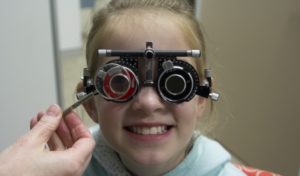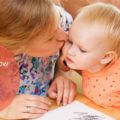
Parents often ask “at what age can I have my child’s eyes checked?” By using appropriate examination techniques, children’s eyes can be assessed at any age (and they should be checked every 2 years). In fact, every week I examine many newborn babies, most of whom are not due to be born for another 2 months or more! Age is no barrier to having your child’s eyes assessed.
During their eye check, all children will have an assessment of their vision using a test that is appropriate for their age and development. There are specialized techniques for measuring vision in babies (observing their eye contact and visual reflexes), older babies and toddlers (using visual acuity measurement systems, which rely on the human brain’s preference to look at something rather than nothing), through to young children (using age-appropriate picture cards or by playing a matching game. Aged 4-5 years and above, simplified versions of the usual adult vision test can be used.
Every child will also undergo an assessment of ocular alignment, which determines if the eyes are used together when looking into the distance and also nearby. The function of the muscles that control eye movements are assessed and the ability of the child to use their eyes together to see in 3D is measured. We do this using a series of interesting toys to take the child’s visual attention where it is needed for us to make our assessments. We often use small prisms and special cards to measure 3D vision as well.
The anatomy of each eye is assessed and the child’s refraction (far- or near-sightedness and astigmatism) is quantified. Both of these things require the child’s pupils to be dilated with specific eye drops. These drops take 20-30 minutes to have their full effect and will cause pupil enlargement and blurred vision for approximately 3 hours. The majority of children find the drops unpleasant (they sting for about 10 seconds when first put in) but it is a critical part of the assessment. An assessment without dilating drops is a partial assessment only.
Depending on the child’s signs and symptoms, other special assessments may be needed. These may include using the slit lamp, using the fluorescent yellow eye drops, having a patch put over 1 eye for a period of time or having photographs or scans performed.
Sometimes children are not interested in the games or strategies we use to assess their eyes or are unable to co-operate on that day. In these instances we gather as much information as we possibly can, but sometimes a second assessment is required for thoroughness. Whilst a visit to the ophthalmologist with your child has its challenges, your child should be treated with kindness and patience and the majority of children find it a fun, playful and interesting experience.

